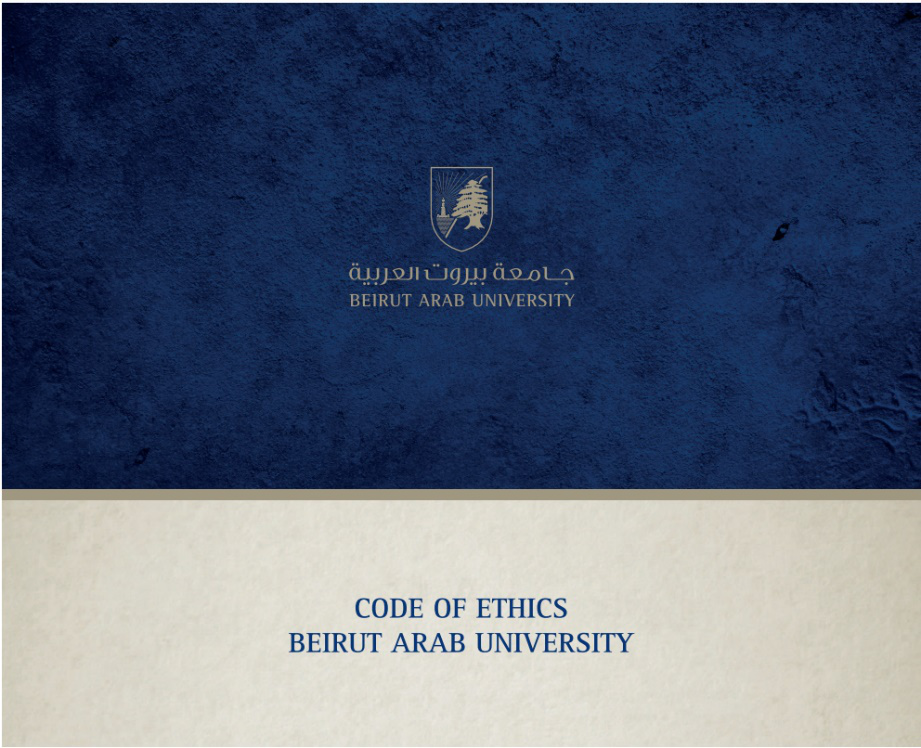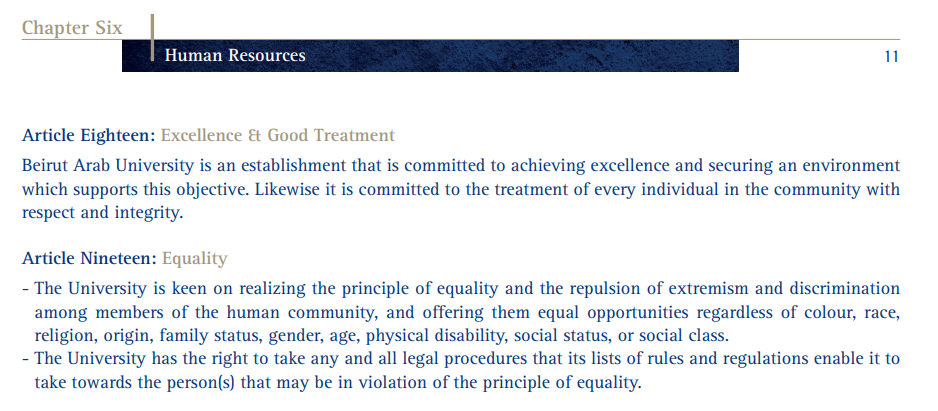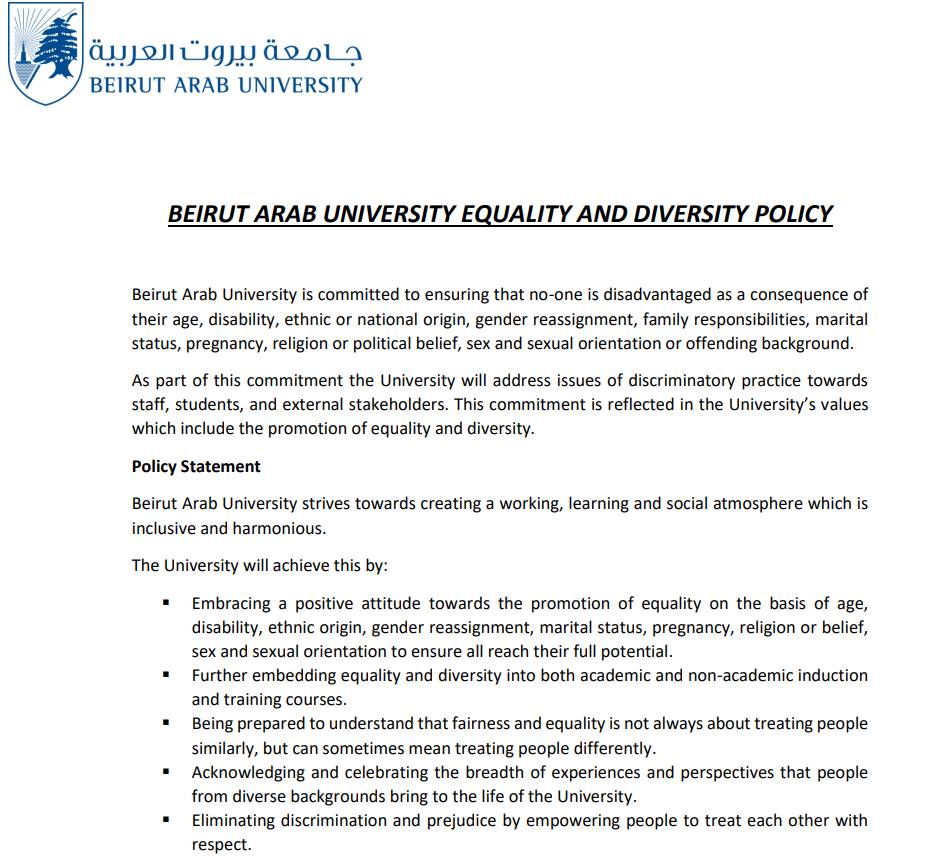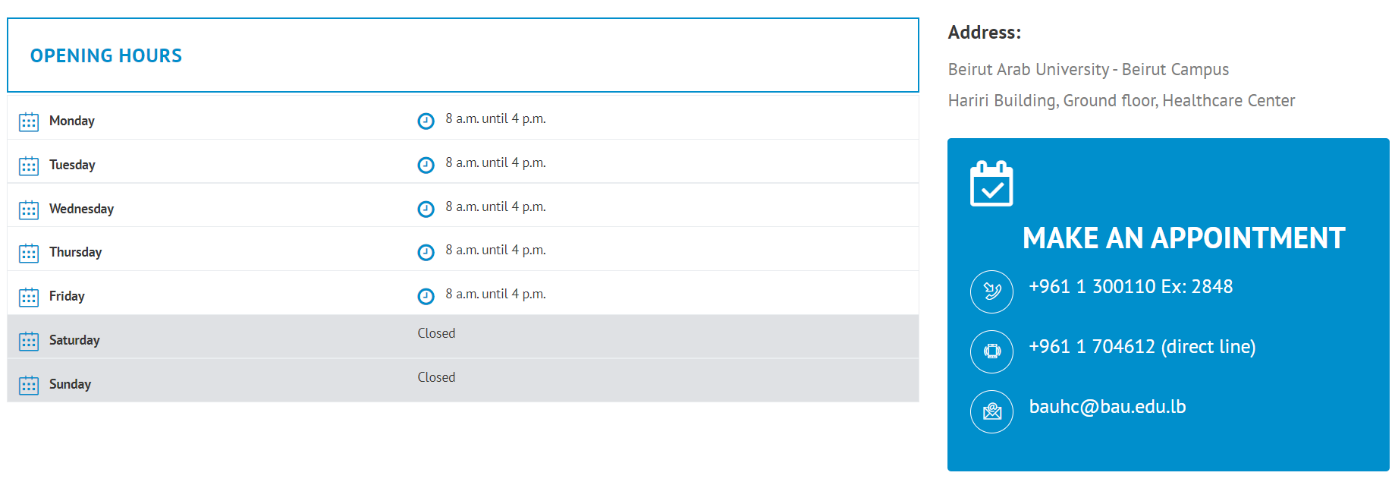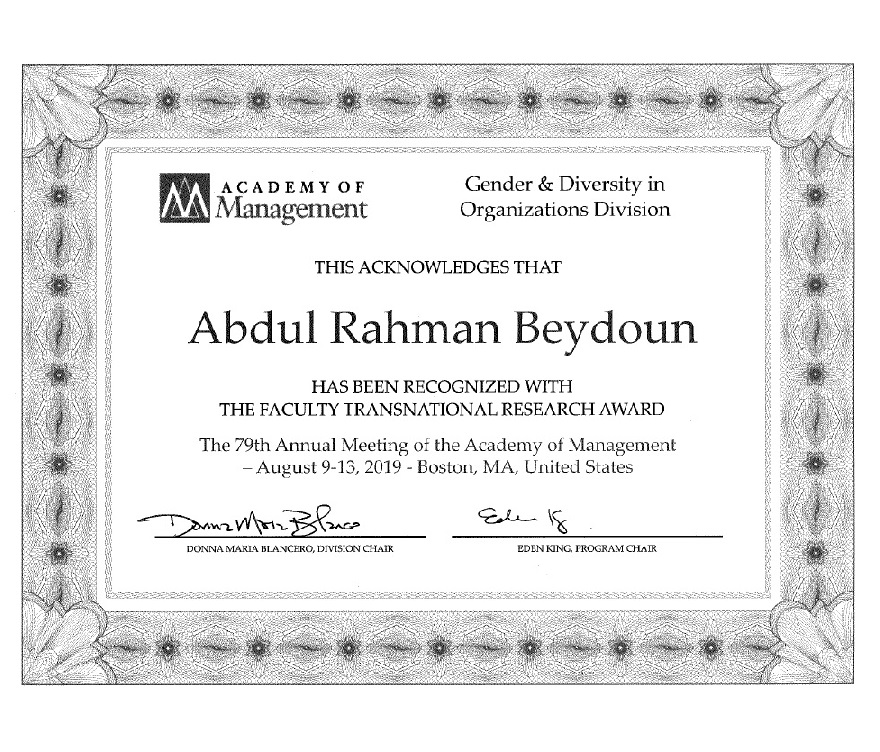Policy that ensures that access to these activities is accessible to all, regardless of ethnicity, religion, disability or gender
Beirut Arab University rejects any type of discrimination, whether it be of ethnicity, religion, disability or gender, for this reason it has a code of ethics and an Equality and Diversity Policy that aims to ensure students and staff members that they are not It will present no type of discrimination and if it is presented, the University will take immediate action for the mental and physical well-being of the affected person. BAU supports gender diversity and inclusion.
BAU to ensure equality and fairness in academic work processes for students and staff members of the University and has a code of ethics in which the values of the University are highlighted and the rejection of any type of discrimination that may arise.
BAU Code of Ethics – University Values
The University’s basic values are academic distinction, honesty and integrity in teaching and scientific research, autonomy, freedom in conducting research, respect for individuality and safety, social justice, equality amongst individuals, scientific integrity, good conduct, setting good role-models, and honorable representation of the University. It is the responsibility of the persons active within the context of the University to uphold these values through:
Committing to integrity of behavior which is translatable into professional excellence and ethical behavior.
Adhering to responsible and decisive attitudes in their actions.
Adhering to the practice of tolerance in their human relations.
Openness towards new ideas that intrinsically bear elevated objectives.
Enhancing benevolent and parental relations between staff members and the students.
BAU Code of Ethics – Excellence & Good Treatment
Beirut Arab University is an establishment that is committed to achieving excellence and securing an environment which supports this objective. Likewise it is committed to the treatment of every individual in the community with respect and integrity.
BAU Code of Ethics – Equality
The University is keen on realizing the principle of equality and the repulsion of extremism and discrimination among members of the human community, and offering them equal opportunities regardless of colour, race, religion, origin, family status, gender, age, physical disability, social status, or social class.
The University has the right to take any and all legal procedures that its lists of rules and regulations enable it to take towards the person(s) that may be in violation of the principle of equality.
Beirut Arab University is committed to ensuring that no-one is disadvantaged as a consequence of their age, disability, ethnic or national origin, gender reassignment, family responsibilities, marital status, pregnancy, religion or political belief, sex and sexual orientation or offending background.
As part of this commitment the University will address issues of discriminatory practice towards staff, students, and external stakeholders. This commitment is reflected in the University’s values which include the promotion of equality and diversity.
Policy Statement
Beirut Arab University strives towards creating a working, learning and social atmosphere which is inclusive and harmonious.
The University will achieve this by:
Embracing a positive attitude towards the promotion of equality on the basis of age, disability, ethnic origin, gender reassignment, marital status, pregnancy, religion or belief, sex and sexual orientation to ensure all reach their full potential.
Further embedding equality and diversity into both academic and non-academic induction and training courses.
Being prepared to understand that fairness and equality is not always about treating people similarly, but can sometimes mean treating people differently.
Acknowledging and celebrating the breadth of experiences and perspectives that people from diverse backgrounds bring to the life of the University.
Eliminating discrimination and prejudice by empowering people to treat each other with respect.
The University’s Approach
The University believes that the most effective way to promote equality and eradicate discrimination is to mainstream the consideration of equality across its functions. In this respect, all employees, students, and visitors to the University have an individual duty to ensure that equality and diversity is actively promoted.
Ultimate responsibility for overseeing this approach rests with the Board of Governors which delegates responsibility to the Principal and Vice Chancellor who, in turn is assisted by the Executive. To ensure there is effective leadership within the University, one of the Vice-Principal and Pro Vice-Chancellors assumes the role of having overall strategic responsibility for the promotion of equality and for the mainstreaming of equality and diversity and is supported by the Equality and Diversity Sub-Committee (EDSC).
Implementation
Mainstreaming equality and diversity is the responsibility of the EDSC, comprised of membership from a wide range of the university’s administrative functions and staff and students to ensure it represents staff and student experiences at the University.
The mainstreaming of equality and diversity includes ensuring that staff are aware of their responsibilities, the University does this through mandatory new staff training and periodic refresher training, both of which are embedded in the University’s values and strategy.
The University is committed to creating and promoting a working and learning environment where everybody is treated with respect.
Responsibilities
Ensure that the University has an effective Equality and Diversity Policy.
Ensure that the University’s equality and diversity policies and action plans are regularly reviewed and updated as necessary, to ensure compliance with all statutory obligations.
Make available the necessary resources for the effective operation of all University activities.
Ensure that responsibility for equality and diversity is properly assigned and promote active acceptance of this responsibility throughout the University.
Work to secure a culture of active engagement with equality and diversity issues.
In the event of any type of discrimination against a staff member or student of the university, BAU will make the Psycho-Social Unit available to the affected person, which will take care of the mental health of the student or staff member to provide the necessary guidance and support to overcome the situation.
Beirut Arab University Healthcare Center (BAUHC) - Psycho-Social Unit
In the light of the accelerating rhythm of modern life and the increasing needs of university students for support, both psychologically and socially, to be able to better face the stressors and difficulties of daily life, the Faculty of Human Sciences (Psychology Department) proposes the establishment of the Psycho-social Unit at BAU.
This unit becomes an inevitable requirement for the welfare of BAU students and staff. Such a step will be a pioneering contribution by BAU among Lebanese universities. The Unit offers counseling services and interventions, including but not limited to psychological, social and educational services for the students. These services are rendered in accordance with world-wide counseling, therapeutic psychological and ethical standards which regulate psycho-social services. The guiding principle for the Unit is nondiscrimination and equality.
The faculty of The Business Administration at Beirut Arab University is proud to announce that Dr Abdul Rahman Beydoun, assistant Professor in the Business administration department, the winner of the prestigious award delivered by the Academy of Management, gender and diversity in organizations division at its 79th annual meeting of the academy of management held on August 9-13,2019 Boston, MA, United States.
Article Seven: Tolerance and Acceptance of the Other
Academic staff, researchers, non-academic staff and students should show tolerance and acceptance of the Other.
Article Eighteen: Excellence & Good Treatment
Beirut Arab University is an establishment that is committed to achieving excellence and securing an environment which supports this objective. Likewise it is committed to the treatment of every individual in the community with respect and integrity.
The University is keen on realizing the principle of equality and the repulsion of extremism and discrimination among members of the human community, and offering them equal opportunities regardless of colour, race, religion, origin, family status, gender, age, physical disability, social status, or social class. - The University has the right to take any and all legal procedures that its lists of rules and regulations enable it to take towards the person(s) that may be in violation of the principle of equality.
Article Twenty - Five: The Use of Resources
Academic staff, non-academic staff and students at the University should use the facilities, equipments and tools that are in their care for the purposes they are designed for, in accordance with their nature, and not in violation of legally acknowledged requirements of general safety. They also have to use these resources wisely to ensure that the returns would benefit as many as possible of the University community members.
It is prohibited to use the University resources for personal benefit, unless prior authorization to do so has been issued in writing by the University.
The University resources include, but are not restricted to, telephones and other communication networks, data services and network links, University vehicles and machinery, various equipment such as computers, etc., in addition to financial tools that assist in purchases such as credit cards and ancillary expenses
Students Level:
“Workforce diversity”, was considered as a coin surfaced in the 1990s (Quinetta, 2019). There has been a growing urge to understand workforce diversity better, in a more profound manner than what is observed at the surface level (Jain and Verma, 1996). Allowing managers to understand the main obstacles facing diversifies workgroups. In the 1990s, emerge of globalization enforced a novel trend for working team diversity. Workgroups in this research are production-oriented, which is linked to the manufacturing or to the service industry.
Diversity is all about differences and nuances. Even though many organizations are now providing what is known as “diversity training” for employees, however, it is mainly not a skill that employees get training on. (DuPont, 1999), diversity basically stands for "differences". In this research particularly, it means "differences within employees." The way an organization uses diversity defines whether it is an asset or a liability. Diversity can be accurately defined as a worldwide singularity that can be used with a set of differences, similarities or challenges amidst any collective mixture (Anita and Swamy, 2018).
In addition, diversity is considered a group’s attribute. It habitually it is concerned with demographic differences among the members of a group (McGrath, Berdahl, and Arrow, 1995). It should be noted that diversity within a workgroup is not only tied to perceived characteristics, since it also encompass invisible attributes such as various educational background, experience, learning style, creativity, and problem-solving aptitude (Nafukho et al., 2011). This research considers four main types of diversity, which widely used in the literature to examine the universal concept of diversity in different context, as follow:
Gender Diversity:
When discussing gender diversity in terms of a work environment, it means that employees from both sexes are hired at alike, receiving equal rewards for the same work, in addition to equal work promotion opportunities.
Recently, both women and men work alongside in different careers. Mainly, there are no jobs that are more "female" or others that are more related to "male" roles. Accordingly, both are requested on a daily basis to interact with each other in a fair and equal way. This causes unrest and discomfort for some individuals, which lead to conflict within a certain workgroup. In Lebanon, women are perceived as non-aggressive, non-competitive, passive, and dependent; and are raised upon such values. They learn to sacrifice for the sake of relationships.
While Males might learn how to play an early life role; they are predictable to be controlling, independent, and competitive. Individuals often expect others to react and respond in the same manner, considering different behavior as wrong behavior (Kauser and Tlaiss, 2011). Gender communication raises an opportunity for rectifying wrong ideas.
Also, effective communication among a diverse workforce requires neglecting gender differences and offering equal opportunities for different individuals (DuPont, 1999).
Marital Status Diversity:
An employee is adjusted by his legal status, his family state, and his commitment towards his family responsibilities (Deshpande, 2013). Marital status is thought as to whether or not the worker is married, unmarried, widowed, single, live-in relation, separated or unmarried. This has a bearing on the worker’s work-life balance and social satisfactoriness within the geographic point and his performance. During this analysis, in this research, the classes of marital status are married, separated, and single.
Educational Diversity:
The educational qualifications mean certification the employees have acquired from his school, institute, college, and university, not only does the education qualify the employee to acquire jobs and positions in the hierarchy in the organization, but also it emphasizes the competency required by them to perform assigned job responsibilities (Deshpande, 2013). Workgroups have become the main structural units of most existing firms (Valls, et al., 2016).
The idea that group members have varied perspectives, ideas, proficiencies, level of education, and information, supports this trend. When an organization faces problems, it is diverse workgroups that are better prepared and equipped to deal with these complex problems (West, 2001). Members of work teams in certain business sectors have been taught common key contents. Members with various educational levels are required due to distinct, complicated teams' jobs. Academic skills can be acquired by people according to availability, capability, and experience.
Moreover, educational background impacts the employee’s perception of workforce diversity. Hence the educational background of the employee is a secondary dimension, depending upon the type of education acquired and skill acquired can make the person capable of doing the designated jobs (Deshpande, 2013).
Work Experience Diversity:
Work experience is the extent of experience in a certain job (McDaniel et al., 1988). It’s argued that relative individual differences in work experience and not complete ones yield individual differences in work knowledge, and work performance. Meanwhile, Avolio and colleagues (1990) pointed out that work experience can be considered as performance foreteller than age differences. Experience gives maturity to the employees and makes them aware of the work processes and the organizational expectations (Deshpande, 2013).
Skilled workers are commonly viewed as reliable, faithful, and devoted. They are also seen as entities that have a robust work ethic and performance record. This is owing to long work experience in related fields.
Staff Level:
Performance in the firms' environment, can be defined as the scope in which member of an organization participates reaching organizational goals. Hence, employees are considered as the main source for enhancing service-oriented firms' performance (luthans and stajkovic, 1999; Pfeffer, 2005).
Tasks in organizations are performed with the aid of resources such as employees, machines, money, and materials. Unlike other resources, employee as a living and a generating resource have particular objectives to attain. Through using the resources, such objectives can be attained. Out of all these resources that are essential, employees are considered as the most important. This is because they play a major role in performing tasks with the aim of accomplishing the goals (Kumudha and Jennet, 2018).
Performance is a specific term that refers to the behaviors which an individual displays while concepts, similar to effectiveness and output mirror the results of those behaviors, which can be under employees` control or not (Campbell et al., 1990). In addition, Altındağa and Kösedağıa (2015) argued that performance as an effective effort performed for reaching a goal or a success to fulfill the job and execute it with achievement. As such performance is split into two parts; the first part is quantitative, and the second is a qualitative expression, where the business, group, or employees doing the job are trying to reach the goals related to this work.
Task Performance:
Individual task performance is basically composed of factors engaged with role-prescribed behavior along with formal job responsibilities, and these factors include skills, motivation, knowledge, abilities and others. (Ang et al., 2007), Moreover, Borman and Motowidlo (1993) illustrated that task performance can be defined as an “employee’s proficiency with which he or she undertakes activities that contribute or adds value to the organizational technical core”.
Organizational Citizenship Behavior (OCB):
Organizational citizenship behavior is made up of employee behaviors that are not only limited to the call of duty (Kinicki and Kreitner, 2008). Examples to such are “gestures as constructive statements about the department or organization, expression of personal interest in the work of others, suggestions for progress, care for organizational property, training new employees.” Remarks have shown that organizational citizenship behavior positively correlates the rates of performance (Moestaina and Kadir, 2020, pp. 1214)
Eventually, any manager is instantly concerned to promote organizational citizenship behavior inside his own organization, owing to the impact it has on the organization’s performance (Podsakoff et al, 2009).
Creative Performance:
The creation and generation of original and valuable ideas associated with organizational products, services, and procedures is known to be creative performance (Amabile, 1988; Oldham and Cummings, 1996). To realize creative performance, one must take risks because the results for modern may deviate from the expected desired outcome (Zhou and George, 2001). “Creativity is defined as something that is novel-original and useful-adaptive” (Feist, 1998). Creativity has been examined by scholars in various fields through different methods, which tries to illustrate its measurements. Some studies focused on individual differences as a source for employee creativity, such as inherent motivation (Amabile, 1988).
It holds the following core values:
Integrity: To adhere to ethics, honesty, accuracy, fairness and professionalism in all daily activities.
Respect: To treat each other with civility and dignity.
Creativity: To enhance critical thinking and innovativeness for personal skills development.
Leadership: To develop leadership and management skills at various levels and continue to learn and share ideas.
Excellence: To recruit and retain qualified academic professionals, maintain outstanding academic and clinical experience, and provide innovative interprofessional education. Moreover, to develop critical thinkers and lifelong learners and developing leadership in oral health care and community service.
Diversity: To promote tolerance of differences and respect the diversity of its academic and administrative staff, students, and patients with equity and fairness.
Accountability: To be committed to maintain the loyalty and good will of our community.
Social Responsibility: To contribute to the society’s needs, services, intellectual, cultural, spiritual and economic progress.
